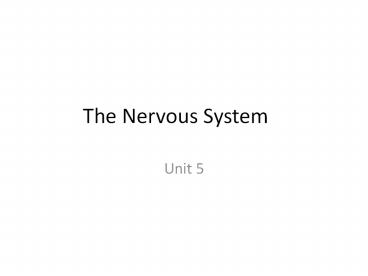The Nervous System - PowerPoint PPT Presentation
1 / 17
Title:
The Nervous System
Description:
... disorders of the nervous system is called neurology. Structures/Anatomy The nervous system is ... anatomy of the nervous system The physiology of the ... – PowerPoint PPT presentation
Number of Views:129
Avg rating:3.0/5.0
Title: The Nervous System
1
The Nervous System
- Unit 5
2
Introduction
- The branch of medical science that deals with the
normal functioning and disorders of the nervous
system is called neurology.
3
Structures/Anatomy
- The nervous system is made up of the following
structures - Brain
- Spinal Cord
- Nerves
- Ganglia (coordination in the body)
- Plexuses (regulate digestion)
- Receptors
4
Functions/Physiology
- Three basic functions
- Sense sensing changes with sensory receptors
- fullness of stomach or sun on your face
- Integrate interpreting and remembering those
changes - Move reacting to those changes with effectors
- muscular contractions
- glandular secretions
5
Parts of the Nervous System
- There are two main parts of the nervous system.
- Central Nervous System (CNS)
- Peripheral Nervous System (PNS)
6
CNS
- The central nervous system is made up of your
brain and your spinal cord. - Its job is to coordinate all of your bodys
activities.
7
PNS
- The peripheral nervous system is made up of all
the nerves that carry messages to and from the
CNS. - It is separated into 2 divisions
- The Somatic Nervous System
- The Autonomic Nervous System
8
PNS Somatic Nervous System
- The somatic nervous system relays information
between your skin, the CNS, and your muscles. - It is voluntary, which means you control it.
- This is how you move your body where you want it
to go.
9
PNS Autonomic Nervous System
- The autonomic nervous system controls your
involuntary reactions. - It is also divided into 2 parts
- Sympathetic Nervous System controls your
internal functions during times of stress, fight
or flight - Parasympathetic Nervous System controls your
internal functions during times of relaxation,
rest and digest
10
Neurons
- Neurons are the basic units of structure and
function of the nervous system. - They are also called nerve cells.
11
Neurons
- Parts of a neuron
- Dendrites branchlike extensions of the neuron
that receive impulses and carry them towards the
cell body - Axon an extension of the neuron that carries
impulses away from the cell body and towards
other neurons, muscles, or glands
12
3 types of neurons
- There are three types of neurons
- 1. Sensory neurons carry impulses from the body
to the spinal cord and brain - 2. Interneurons are found within the brain and
spinal cord and relay messages. - 3. Motor neurons carry the response impulses away
from the brain and spinal cord to muscles and
glands
13
Relaying an impulse
- 1. You are exposed to a stimulus.
- 2. Sensory neurons send the message to the brain.
- 3. Interneurons in the brain help translate the
message. - 4. Motor neurons send a message back to the
muscles. - 5. The muscles are activated and respond to the
stimulus.
14
Connections between neurons
- Neurons dont touch each other, there are gaps
between them called synapses. - Chemicals called neurotransmitters travel across
the synapses to help neurons communicate.
15
Neurotransmitters
- Serotonin contributes to feelings of well-being
or happiness, not enough can cause depression - Dopamine coordinates movement, not enough can be
caused by Parkinsons disease - Epinephrine regulates heartbeat, blood pressure,
and the size or your airways, can be given to
people having an allergic reaction
16
Unit 5 Diseases and Disorders
Disease Cause Symptoms Susceptibility Treatment Prognosis
Multiple Sclerosis
Epilepsy
Guillain-Barre Syndrome
Neuroblastoma
Rabies
Shingles
Polio
Raynauds Phenomenon
Parkinsons
Cerebral Palsy
Narcolepsy
Aging
17
Unit 5 Project TheaterGroups of 1-4
- Create, memorize, and perform a 3-5 minute skit
explaining a disease or disorder of the nervous
system. - You will turn in your script, along with a
4-paragraph written component that includes - The anatomy of the nervous system
- The physiology of the nervous system
- How the nervous system interacts with other body
systems - How the nervous system helps your body maintain
homeostasis

